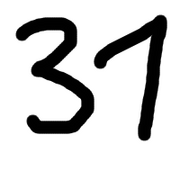No edit summary |
No edit summary Tag: Visual edit |
||
| Line 7: | Line 7: | ||
|cardinal-number = thirty-one |
|cardinal-number = thirty-one |
||
|Base-2 Form = 11111 |
|Base-2 Form = 11111 |
||
| − | |Base-3 Form = 1011 |
||
| − | |Base-4 Form = 133 |
||
| − | |Base-5 Form = 111 |
||
| − | |Base-6 Form = 51 |
||
| − | |Base-7 Form = 43 |
||
|Base-8 Form = 37 |
|Base-8 Form = 37 |
||
| − | |Base- |
+ | |Base-16 Form = 1F |
|previous = [[29|<font color="white">29</font>]] |
|previous = [[29|<font color="white">29</font>]] |
||
| + | |next = [[37|<font color="white">37</font>]]}} |
||
| − | + | 31 is a [[1-100|prime number from 1-100]]. 31 has 2 factors, 1 and 31. It is said to be a number wherein when digits are added together, they make a composite number. It is the eleventh prime number, and the eleventh prime number from 1-100. [[File:31.png|thumb]] |
|
==Proofs== |
==Proofs== |
||
*1 can divide 31 |
*1 can divide 31 |
||
Revision as of 02:08, 2 February 2014
31 is a prime number from 1-100. 31 has 2 factors, 1 and 31. It is said to be a number wherein when digits are added together, they make a composite number. It is the eleventh prime number, and the eleventh prime number from 1-100.

Proofs
- 1 can divide 31
- 2 cannot
- 3 cannot
- 4 - 28 cannot
- 29 cannot
- 30 also cannot
- 31 can divide itself
Relationship with other odd numbers
The numbers before
- The previous odd number, 29, is a prime number.
- There are no odd numbers between 29 and 31. As a result, they are twin primes.
- Before 29, the previous two odd numbers are 25 and 27. 25 is a square number, being 52 = 25. 27 is a cube number, being 33 = 27.
- The prime number previous to 29 is 23.
The numbers after
- The next odd number, 33, is not a prime number. It is divisible by 3 and 11.
- The next odd number, 35, is also not a prime number. It is divisible by 5 and 7.
- 37, the odd number following 35, is a prime number.
- 31 and 37 are six numbers apart; therefore, they are sexy primes.
